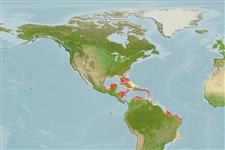Demospongiae |
Poecilosclerida |
Crambeidae
Environment: milieu / climate zone / depth range / distribution range
Ecology
Reef-associated; brackish; depth range 2 - 58 m (Ref. 108813). Tropical
Western Atlantic.
Length at first maturity / Size / Weight / Age
Maturity: Lm ? range ? - ? cm Max length : 80.0 cm H male/unsexed; (Ref. 415)
Encrusting, massive: 0.2 - 4 cm or ramose: 50 - 80 cm high. Dark red externally and internally. Surface has a transparent-whitish membrane, with radial canals that converge in oscula: 0.3 - 2 cm in diameter (Ref. 415). Low or tall masses in bushy, rounded or fan-shaped forms; occassional short tube-like lobes ending in oscules. Short, irregular branched extensions, or ridges or lumps, supported by subdermal skeletal elements. Elevated oscules. Transparent exhalant canal systems may converge around oscules, revealing red to red-orange interior color, but collapses and becomes inconspicuos when animal is taken out of water. Soft tissue consistency; exudate stains fingers when handled. Tough skeleton. Plumose tracts of the principal subtylostyles support encrusting specimens at the base; while a central meshwork of plumose spicules surrounded by spongin are present in thicker, bushy, massive and fan-shaped specimens (Ref. 85482).
Common on species in shallow reefs. In cryptic habitats it grows as thin crust (Ref. 415); may encrust dead corals, mollusk shells and gorgonian axes. Also on hard bottoms (Ref. 85482) and mangrove ponds (Ref. 86789).
Life cycle and mating behavior
Maturity | Reproduction | Spawning | Eggs | Fecundity | Larvae
Members of the class Demospongiae are hermaphroditic. Life cycle: The zygote develops into parenchymella larva (free-swimming) before settling down on a substrate where it grows into a young sponge.
Collin, R., M.C. Díaz, J. Norenburg, R.M. Rocha, J.A. Sánchez, M. Schulze, A. Schwartz and A. Valdés 2005 Photographic identification guide to some common marine invertebrates of Bocas Del Toro, Panama. Caribbean Journal of Science. 41(3):638-707. (Ref. 415)
IUCN Red List Status
(Ref. 130435: Version 2025-1)
CITES status (Ref. 108899)
Not Evaluated
Not Evaluated
Threat to humans
Harmless
Human uses
| FishSource |
Tools
More information
Trophic EcologyFood items (preys)
Diet composition
Food consumption
Predators
Population dynamicsGrowth
Max. ages / sizes
Length-weight rel.
Length-length rel.
Length-frequencies
Mass conversion
Abundance
Life cycleReproductionMaturityFecunditySpawningEggsEgg developmentLarvae PhysiologyOxygen consumption
Human RelatedStamps, coins, misc.
Internet sources
Estimates based on models
Preferred temperature
(Ref.
115969): 23.6 - 28, mean 26.5 (based on 194 cells).
Fishing Vulnerability
Moderate to high vulnerability (52 of 100).
Price category
Unknown.
